Deur Chris Grinter, op 24 Februarie, 2010
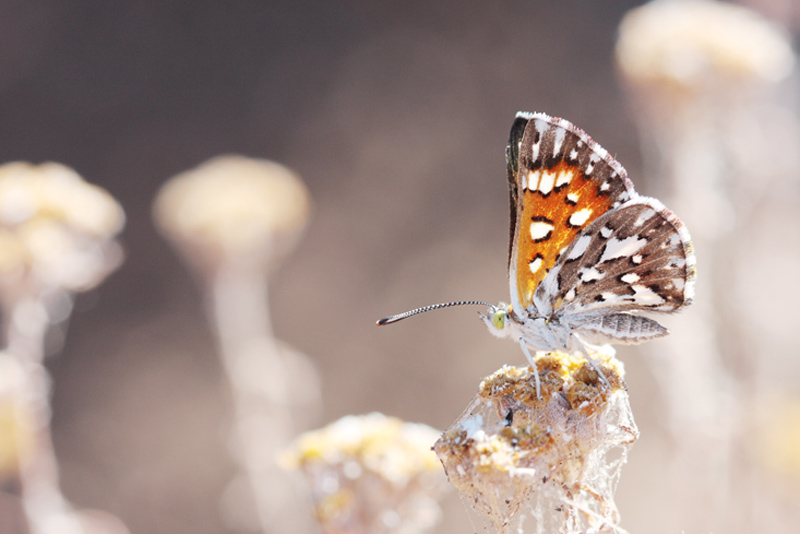
Weet dit vlinder? Dit is OK, niemand regtig. Dit is in die genus Apodemia (Riodinidae), maar die taksonomie van hierdie groep is 'n ramp… en nie eens my begin op die subspesie. Hierdie eksemplaar is gefotografeer in September, wat beteken dit is waarskynlik Apodemia mormo te wees (Mormoonse) based on flight time. A. Mormoonse is a fall flyer and A. virgulti is a spring flyer. While some forms seem distinctive, there is massive morphological overlap and they are usually identical and sympatric – actually down to living on the same plants. But according to lab experiments it is impossible to get the pupae to break diapause so they remain reproductively isolated. So are they different? While molecular work is being conducted the verdict is out, but it does seem like these two species may be retained in the end. En natuurlik, each mountain range has it’s own subspecies. Who knows, I sure don’t. I’m glad I don’t work on butterflies.
Species concepts are a fuzzy line and it’s never clear exactly where to make the cut. When asked what a species is most people default to the Mayr concept of Biological Species (BSC), where reproductive isolation = new. This is all well and good but we have to keep in mind that this is not the ONLY species concept. Daar is dosyne, and not one is perfect. Groups like Grammia (Noctuidae: Arctiinae) exhibit high levels of hybridization, which does not adhere well to the BSC. I like to apply as many criteria as possible to delimit a species and it seems like the line is all too commonly thin within insects. I like to see a distinguishing morphological trait, if not in wing color or pattern, at the least in the genitalia or antennae. This is not always the case however and you have to look at the biology and/or DNA. I have looked at two insects that are for all intents and purposes identical. But the biology is radically different and a large % difference (oor 8% – Ja, arbitrary) in their DNA makes it unquestionable that they are separate.
And if species weren’t contentious enough subspecies stir the pot even more. I’m skeptical about the entire concept, but there are cases in which it seems plausible and necessary. A subspecies is a more formal definition of a geographical “vorm” and usually exhibits a blend zone into another subspecies. For instance if you look at the 27 different populations of Plebejus icarioides there are large differences between northern and southern populations, but very subtile difference along the gradient. It is that persistent gradient that creates one dynamic species instead of 27 separate species – at least according to current research. Moths have been lucky and have thus far avoided the plague of over-subspeciation, butterflies not so much. There may even be instances where greedy collectors have named new subspecies of Parnassius for profit (new rare butterfly subspecies sell for big bucks).
The truth is that species concepts are artificial, poorly understood and dynamic at best; at worst it approaches a soft science with no real possibility of proof. Yet species are real and theories will continue to adapt while we sit here and scratch our heads.
Deur Chris Grinter, op 23 Februarie, 2010 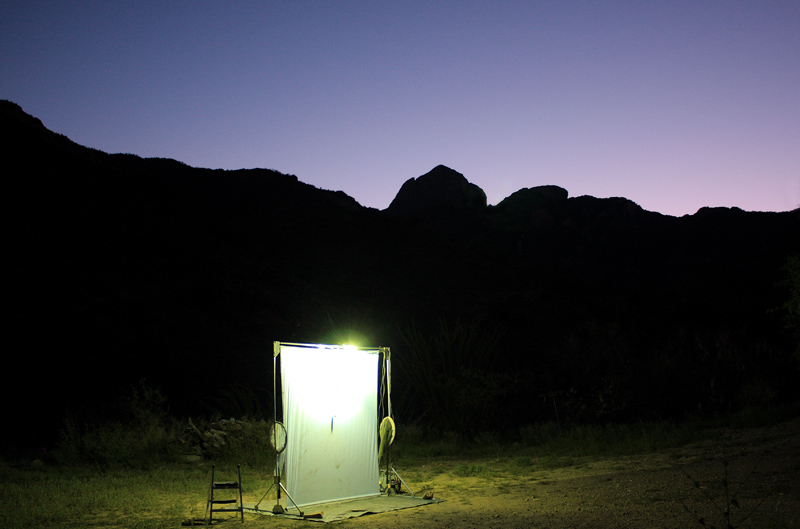
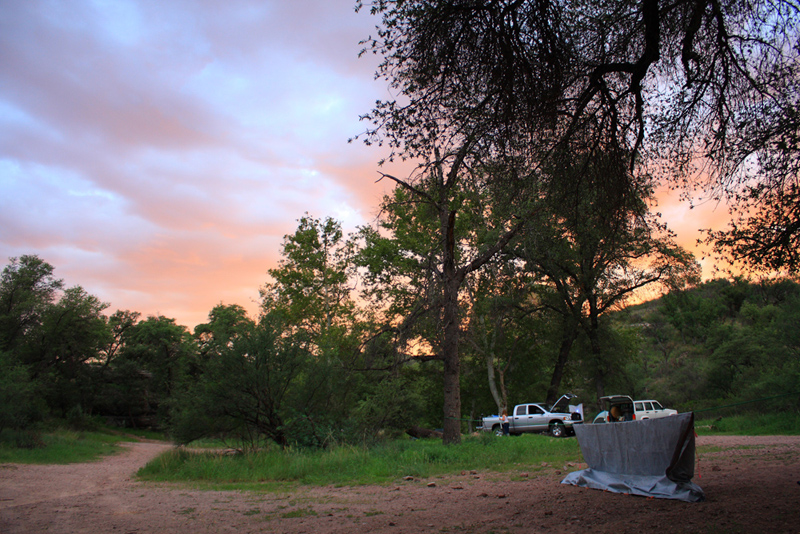
Een van die voordele van om 'n entomoloog reis en te versamel. Ek het 'n paar duisend myl op die motor elke somer en dit is twee van die beste plekke in Arizona in te samel. Die top beeld is van die Baboquivari Berge (Baboquivari Peak in die middel), Brown Canyon Navorsingstasie. Die onderste foto is van Pena Blanca Canyon, 'n bekende versameling hotspot. Dit canyon is net 5 myl van Mexiko en het 'n paar kommer oor veiligheid as gevolg van ons huidige immigrasie beleid. Een oggend, terwyl sorteer motte van die vorige nagte vang, 'n kollega en ek het 'n groep van sowat 30 onwettiges loop reg deur die kamp. Hulle was goed geklee en skoon, waai, en moet nou net afgelaai by die heining. Gelukkig het die meerderheid van die onwettiges is hardwerkend en eerlike mense probeer om 'n beter lewe te verdien. Dit is die coyotes en smokkelaars wat vreesaanjaend – Ek het stories van die Mexikaanse polisie begelei dwelm karavane in die VSA met 'n swaar artillerie gehoor. En net verlede jaar 'n grens patrollie agent is doodgesteek deur 'n coyote in hierdie omgewing.
Gelukkig, 'n klomp van vreemde ouens rondstaan vreemde ligte by nagte gee ons 'n groot bed.
(Is hierdie beelde klein genoeg om vinnig te laai?)
Deur Chris Grinter, op 23 Februarie, 2010 Ondanks die feit dat redelik glad nie geïnteresseerd in skoenlappers, hulle is redelik om te kyk na. Hier is 'n baie groot video deur 'n ou wat ek ken in Suider CA. Sy time-lapse video's van lepidoptera lewensiklus is redelik indrukwekkend, en hierdie een in die besonder mooi. As jy sny tot ongeveer 3:00 in, you will see dozens of Great Purple Hairstreaks (Atlides halesus) emerging from their chrysalises, the colors are stunning. This butterfly is native to the SW and Mexico, and I have to admit I love finding it in the field.
[youtube=http://www.youtube.com/watch?v=KyWJlpIchkE]
Deur Chris Grinter, op 23 Februarie, 2010 The brief comment about Linus Pauling and Vitamin C below made me remember this video first posted a while ago by Pharyngula. Dit is Kary Mullis, die uitvinder van PCR, en 'n Nobelprys wenner. Sy uitvinding basies DNA ontleding moontlik gemaak. Maar soos Pauling, Hy is ook heeltemal en totaal neute. If you have the time to listen to him ramble, give it a shot. Maar in kort, he discusses astrology, denies global warming and how AIDS is not caused by HIV. I wonder what the stats are for genius scientists that slide off their rocker?
[Vimeo 9167379]
Deur Chris Grinter, op 22 Februarie, 2010 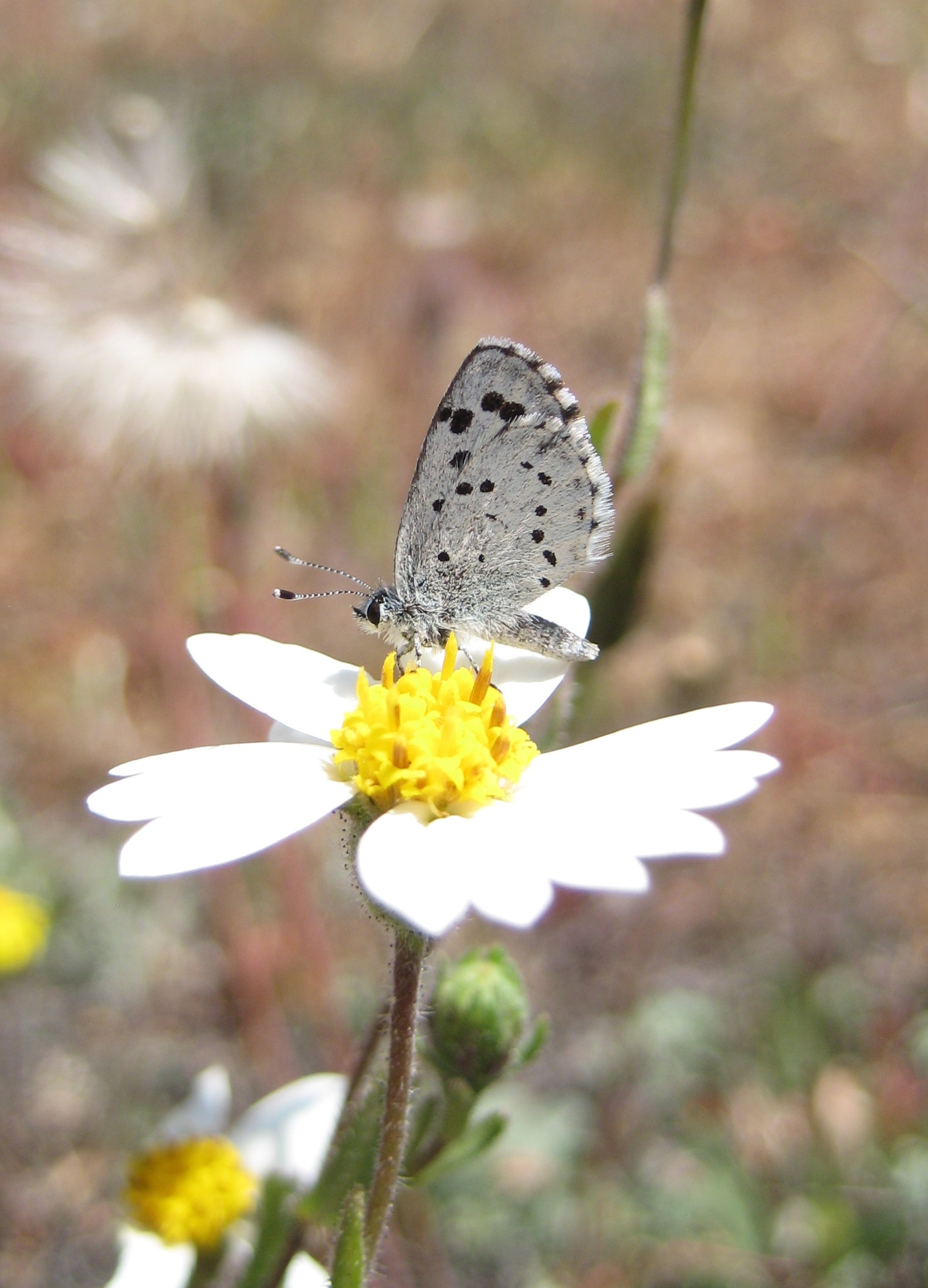
Dit is 'n ou foto van my, so dit is nie volmaak. As jy my hierdie vlinder kan vertel spesies jy 'n hoë-vyf. As jy weet wat die subspesie, Ek sal 'n nuwe pak stuur #3 vlekvrye staal penne! Wenk net: Dit is van die westelike VSA.
Deur Chris Grinter, op 22 Februarie, 2010 Vandag het ek gevind hierdie artikel in NY times health – lok die voordele van akupunktuur gebruik vir depressie verligting in swanger vroue. Ek het 'n paar probleme met die joernalis, Shirley S. Wang, versuim om in haar stuk skepties te bly. Maar dit kom as geen verrassing, ek sal dus nie die moeite doen om ooglopende gebreke in die media uit te wys nie.
Ek sal die gebreke in die studie uitwys. Kry asseblief die oorspronklike volledige teks, hier. So nadat ek hierdie artikel gelees het, het ek tot 'n paar gevolgtrekkings gekom.
1) Baie klein steekproefgrootte van 150 pasiënte, net 141 behandel.
2) Die studie is SLEGS verblind vir die depressietelling, nie toediening van akupunktuur nie. In werklikheid, hul vrylating vorm state "Deelnemers aan een van hierdie twee groepe sal akupunktuur ontvang wat fokus op depressie simptome en die ander behandeling sal nie." Maak sin, om 'n naald in jou vel te kry, is maklik om raak te sien. so, hierdie “gerandomiseer en verblind” deelnemers het geweet wat kom en het aangeneem dat enige steek veronderstel was om hul depressie te help. Verder, hierdie (baie beter) studeer het getoon dat gesimuleerde akupunktuur met tandestokkies net so werk. Versigtig, dit is dwingende bewyse teen die geldigheid van akupunktuur – nie bewyse vir die bruikbaarheid van gestimuleer nie “drukpunte”. Dit is 'n placebo-effek.
3) Studie veronderstel geldigheid van “depressie spesifiek” en “nie-spesifiek” akupunktuur. Dit beteken dat een metode van pensteek op een of ander manier depressie oor 'n ander genees. Waarop is dit gebaseer? Nee wag, hulle sê presies die volledige wetenskaplike bewyse hier: “patrone van disharmonie volgens die beginsels van tradisionele Chinese medisyne”. Ek is jammer, asseblief, gee my moderne medisyne oor 2,000 jaar oue mitiese oortuigings. Hoe was die gemiddelde lewenskwaliteit en lewensverwagting vir 'n antieke Sjinees? Nogal verskriklik, en ek is seker die gemiddelde lewensverwagting het nie oorskry nie 35 jaar.
4) Baseer depressietellings op een administrasie van die DSM-IV Hamilton-graderingskaal. Omdat ek nie 'n psigiater is nie, kan ek nie praat oor die doeltreffendheid van hierdie toetse nie. Maar, Ek sal op 'n ledemaat uitgaan en aanvaar dat 'n sterker basislyn vir depressie vasgestel moet word voordat resultate vergelyk word. Die toets kan akkuraat wees, maar hoekom dit nie meer as een keer toedien om geraas te verminder nie.
5) Seleksie van massering as 'n tweede kontrole. Dit is 'n slegte poging tot skynbare skeptisisme, hulle stel selfs reg van die kolf af “Massering is gekonseptualiseer as 'n kontrole behandeling omdat, alhoewel dit gemoed onmiddellik na 'n sessie verbeter, daar is onvoldoende bewyse om die doeltreffendheid daarvan as 'n behandeling vir depressie te ondersteun.” Wanneer ek 'n studie ontwerp, kyk ek graag na alle bekende faktore wat ek glo my hipotese sal weerlê. Om iets te kies wat jy reeds glo sal misluk, wys net hul hand van growwe vooroordeel.
6) Versuim om te beheer vir sosio-ekonomiese faktore. 67% van die deelnemers was wit, waarvan die meerderheid goed opgevoed was. Hulle gaan selfs so ver as om in die bespreking te verklaar “Daarom, resultate mag nie veralgemeen na spesifieke minderheidsgroepe wat onderverteenwoordig was in ons steekproef nie”. Is dit net ek, of ontken hierdie stelling die geheel van hul navorsing? Hulle gee vrylik toe dat akupunktuur dalk nie so goed in ander minderheidsgroepe werk nie. Hoekom kan dit wees? Die enigste logiese en wetenskaplike antwoord is dat 'n placebo-effek oor sosio-ekonomiese grense verskil. As, na alles, akupunktuur was 'n wettige mediese wetenskap, daar sou 'n onbeduidende verskil tussen fisiologies identiese organismes gesien word.
Hierdie studie is ontsettend slegte wetenskap. Hierdie navorsers begin met die uitgangspunt dat akupunktuur werk, en soek na data om hul eise te ondersteun. Dit is presies die teenoorgestelde van hoe om werklike wetenskap te bedryf. En, ons gesondheidsverslaggewer by die NY Times het nie eens 'n oog geknip nie. Misluk vir jou Mev. Wang, en versuim om die NY Times.
Deur Chris Grinter, op 21 Februarie, 2010 Ek hou van Ming Tsai en sy kook ryk soveel as die volgende 3-am TV kyker. Eintlik, his recipes are fantastic and you should make them yourself. Maar ek het opgemerk 'n vreemde neiging vir Hom te sê: (geparafraseer) “moet jy altyd gebruik organiese, dit is baie beter vir jou”. Dit laat my 'n bietjie verbaas. What exactly does he mean? Ming is well-educated and this is not anything he should be solely responsible for, but he echoes an all too common misconception that organic is actually better. By better I am interpreting this as healthier, which seems to be a logical gap to bridge. so, let’s look at the data.
A recent and comprehensive review published in the American Journal of Clinical Nutrition has largely convinced me of what I was always skeptical of; that organic foods can not actually be healthier for you. In their breakdown they cited 55 studies and came to the conclusion that “there is no evidence of a difference in nutrient quality between organically and conventionally produced foodstuffs”.
So what is the harm? My problem with all of this is that it is based on the naturalistic fallacy, daardie “natural” of “organic” somehow means that the product is safer or healthier. How many times do you see the term “natural” in the store and never give it second thought? If natural things really were safer then traditional Ayurvedic medicines would not be horribly toxic. Afterall, arsenic, lead and mercury are NATURAL – but they are also some of the most toxic compounds known to man. In the end it is 100% marketing.
Taken from another angle Ming Tsai may not be all that incorrect afterall. I do not have all the data in front of me regarding pesticide contamination of foodstuffs, but it is logical to assume the less contaminated the better. Obviously pesticides can be a bad thing, there are mountains of literature to support the damage they can cause. But the jury seems out on exactly how bad, if at all, these minute residues on our foods are. Conventionally grown foods have regulated levels of residues, but even organics are not free of pesticide contamination. So I look at it differently. Our environment benefits from having safer food. Less chemicals are dumped into our waterways, farmers have to battle less with incredibly powerful toxins, en blinky the fish fights to see another day. We should all strive to live sustainably and organic farming does provide us with an edge.
So once again, what is the harm? People who buy organic quite possibly do so based on genuine environmental stewardship. I would also argue that a very high percentage of these people also believe these foods are healthier (anyone have survey data to support this claim?). So in this instance the result is a net positive. Maar, being right for the wrong reasons should never be acceptable. This strikes at the peak of a larger problem that is driven by marketing and zero science. Case in point – Vitamin C as a cold remedy. A study in PLOS medicine has shown there is no indication for efficacy of VitC against the common cold. Gaan figuur, a once believed to be true staple has begun to be picked apart by science and data. Let’s be careful on what bandwagon we jump and why.
Deur Chris Grinter, op 21 Februarie, 2010 [youtube=http://www.youtube.com/watch?v=zSgiXGELjbc]
Ek geniet dit om hierdie autotuned Sagan, maak my ek was hierdie welsprekende. Watch more videos here at the Symphony of Science.
Deur Chris Grinter, op 21 Februarie, 2010 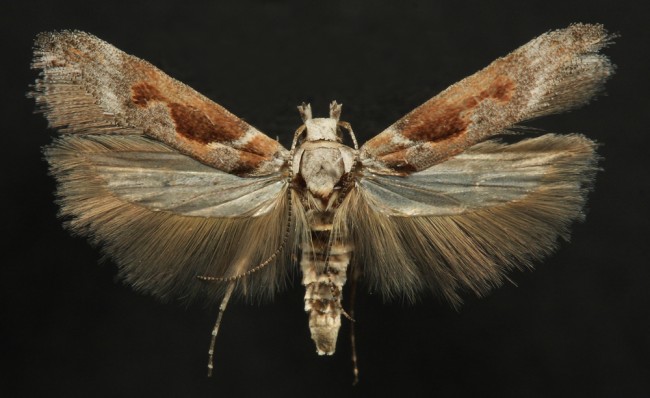 so, how do I begin a new blog? Tough question, but perhaps this is a good time to show off a fun new species. This moth was collected last year outside of Santa Barbara, CA. The massive wingspan, at 15mm, makes it pretty large for a Gelechiid moth. The genus, Gnorimoschema (pronounced nor-a-mosh-ma), seems to be far more species rich than is currently known, so this creature comes as no surprise. It also gives me a chance to brag about the benefits of studying such a wonderfully diverse group of animals. If you happen to be lucky enough to be a friend of mine you’ll probably get your own species at some point. so, how do I begin a new blog? Tough question, but perhaps this is a good time to show off a fun new species. This moth was collected last year outside of Santa Barbara, CA. The massive wingspan, at 15mm, makes it pretty large for a Gelechiid moth. The genus, Gnorimoschema (pronounced nor-a-mosh-ma), seems to be far more species rich than is currently known, so this creature comes as no surprise. It also gives me a chance to brag about the benefits of studying such a wonderfully diverse group of animals. If you happen to be lucky enough to be a friend of mine you’ll probably get your own species at some point.
Aan die ander kant, this also highlights the problem – knowing almost nothing about the most diverse group of animals on our planet. What happens when a new crop is being eaten by a tiny, nondescript, moth? Call one of the dozen people in the world who might be able to help you. Maybe they know what it is, but likely nothing is known about its biology. This is what happened in South Dakota recently when biofuel crops were being eaten by a moth last seen in 1910. What a perfect reason for more funding! More likely than not my new moth above will never explode into a pest. But having basic knowledge of the species that share this earth with us is a step in the right direction.
|
Skeptisisme
|





